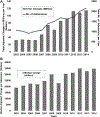Acute Vascular Ischemic Events in Patients With Central Retinal Artery Occlusion in the United States: A Nationwide Study 2003-2014
- PMID: 30689989
- PMCID: PMC6542256
- DOI: 10.1016/j.ajo.2019.01.009
Acute Vascular Ischemic Events in Patients With Central Retinal Artery Occlusion in the United States: A Nationwide Study 2003-2014
Abstract
Purpose: Central retinal artery occlusion (CRAO) confers a high risk of acute vascular ischemic events, including stroke and myocardial infarction (MI). Understanding the burden and risk factor profile of these ischemic events can serve as a valuable guide for ophthalmologists in the management and appropriate referral of these patients.
Design: Retrospective cross-sectional study.
Methods: The Nationwide Inpatient Sample (NIS) was queried to identify all inpatient admissions with a diagnosis of CRAO in the United States between the years 2003 and 2014. The primary outcome measure was the incidence of in-hospital acute vascular ischemic events.
Results: There were an estimated 17 117 CRAO inpatient admissions. The mean age was 68.4 ± 0.1 years and 53% of patients were female. The incidence of in-hospital stroke and acute MI were 12.9% and 3.7%. The incidence of stroke showed an increasing trend over the years, almost doubling in 2014 in comparison to 2003 (15.3% vs 7.7%). The combined risk of in-hospital stroke, transient ischemic attack, acute MI, or mortality was 19%. Female sex, hypertension, carotid artery stenosis, aortic valve disease, smoking, and alcohol dependence or abuse were positive predictors of in-hospital stroke.
Conclusion: There is a significant burden of vascular risk factors, associated with an increased risk of in-hospital stroke, acute MI, and death in CRAO patients. The risk of CRAO-associated stroke is highest in women and in those with a history of hypertension, carotid artery stenosis, aortic valve disease, smoking, or alcohol abuse.
Copyright © 2019 Elsevier Inc. All rights reserved.
Figures


Similar articles
-
Outcomes and Readmission in Patients With Retinal Artery Occlusion (from the Nationwide Readmission Database).Am J Cardiol. 2022 Nov 15;183:105-108. doi: 10.1016/j.amjcard.2022.07.040. Epub 2022 Sep 14. Am J Cardiol. 2022. PMID: 36115725
-
Stroke Risk and Risk Factors in Patients With Central Retinal Artery Occlusion.Am J Ophthalmol. 2018 Dec;196:96-100. doi: 10.1016/j.ajo.2018.08.027. Epub 2018 Aug 25. Am J Ophthalmol. 2018. PMID: 30153430
-
Risk and Risk Periods for Stroke and Acute Myocardial Infarction in Patients with Central Retinal Artery Occlusion.Ophthalmology. 2015 Nov;122(11):2336-2343.e2. doi: 10.1016/j.ophtha.2015.07.018. Epub 2015 Aug 19. Ophthalmology. 2015. PMID: 26298716
-
Long-Term Risk of Myocardial Infarction Compared to Recurrent Stroke After Transient Ischemic Attack and Ischemic Stroke: Systematic Review and Meta-Analysis.J Am Heart Assoc. 2018 Jan 18;7(2):e007267. doi: 10.1161/JAHA.117.007267. J Am Heart Assoc. 2018. PMID: 29348322 Free PMC article.
-
Management of Acute Central Retinal Artery Occlusion, a "Retinal Stroke": An Institutional Series and Literature Review.J Stroke Cerebrovasc Dis. 2021 Feb;30(2):105531. doi: 10.1016/j.jstrokecerebrovasdis.2020.105531. Epub 2020 Dec 10. J Stroke Cerebrovasc Dis. 2021. PMID: 33310593 Review.
Cited by
-
Retinal Findings and Cardiovascular Risk: Prognostic Conditions, Novel Biomarkers, and Emerging Image Analysis Techniques.J Pers Med. 2023 Oct 31;13(11):1564. doi: 10.3390/jpm13111564. J Pers Med. 2023. PMID: 38003879 Free PMC article. Review.
-
Risk Factors and Treatment Strategy for Retinal Vascular Occlusive Diseases.J Clin Med. 2022 Oct 27;11(21):6340. doi: 10.3390/jcm11216340. J Clin Med. 2022. PMID: 36362567 Free PMC article. Review.
-
Subsequent Acute Ischemic Stroke in a Patient with Monocular Vision Loss Associated with Isolated Internal Carotid Artery Occlusion: A Case Report.Neurol Int. 2024 Dec 26;17(1):3. doi: 10.3390/neurolint17010003. Neurol Int. 2024. PMID: 39852768 Free PMC article.
-
Acute Central Retinal Artery Occlusion Seen within 24 Hours at a Tertiary Institution.J Stroke Cerebrovasc Dis. 2021 Sep;30(9):105988. doi: 10.1016/j.jstrokecerebrovasdis.2021.105988. Epub 2021 Jul 13. J Stroke Cerebrovasc Dis. 2021. PMID: 34271275 Free PMC article.
-
[Internistic clarification of retinal vascular occlusions].Ophthalmologie. 2023 Dec;120(12):1287-1294. doi: 10.1007/s00347-023-01961-y. Epub 2023 Nov 27. Ophthalmologie. 2023. PMID: 38010390 German.
References
-
- Hayreh SS, Zimmerman MB. Central retinal artery occlusion: visual outcome. Am J Ophthalmol 2005;140(3):376–391. - PubMed
-
- Savino PJ, Glaser JS, Cassady J. Retinal stroke. Is the patient at risk? Arch Ophthalmol 1977;95(7):1185–1189. - PubMed
-
- Schumacher M, Schmidt D, Jurklies B, et al. Central retinal artery occlusion: local intra-arterial fibrinolysis versus conservative treatment, a multicenter randomized trial. Ophthalmology 2010;117(7):1367–1375.e1361. - PubMed
-
- Chen CS, Lee AW, Campbell B, et al. Efficacy of intravenous tissue-type plasminogen activator in central retinal artery occlusion: report from a randomized, controlled trial. Stroke 2011;42(8):2229–2234. - PubMed
MeSH terms
Grants and funding
LinkOut - more resources
Full Text Sources
Medical

